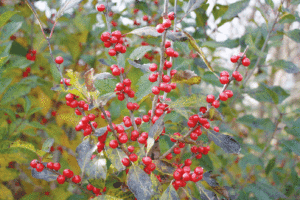
Winterberry thrives in full sun to partial shade in average to wet soils, similar to what is found in the non-tidal marshes and along the stream banks or any poorly drained soils. (Photo by Ginny Rosenkranz)
by Ginny Rosenkranz
Ilex verticillata, also known as winterberry, is a beautiful native holly whose leaves turn a soft yellow in the fall before it loses all its leaves in November to display a huge number of large, brilliant berries that shine in the garden for practically all winter long.
This lovely holly thrives in full sun to partial shade in average to wet soils, similar to what is found in the non-tidal marshes and along the stream banks or any poorly drained soils.
The female plants are able to bloom on new spring growth — so for the best and most brilliant color, trim the plants in the early spring to promote new growth, new flowers and a large number of beautiful berries in the fall.
The native species can grow to the height of three to 12 feet tall while some new, dwarf cultivars grow only two to four feet tall like Ilex “Red Sprite,” a slow-growing plant with large berries, and “Berry Poppins,” which has orange-red berries that fruit heavier than most Winterberries.
These smaller plants will fit into smaller gardens or in the foundation plantings.
Some of the other cultivars that have bright red berries are on a list that includes “Sparkle Berry,” “Winter Red,” “Berry Heavy” and “Berry Nice.”
“Winter Gold” is covered with bright yellow-gold and “Aurantiaca” has orange berries.
Winterberry plants have an open, upright habit that make it easy to prune some of the heavy-berried branches for many ideas of winter arrangements.
All of the female hollies will need at least one male within a mile of the females and one of the newer, smaller deciduous male hollies is “Jim Dandy.”
As with a lot of native shrubs, the Winterberry tends to create small colonies with root suckers, but they can be pruned out if desired.
Besides being used as a foundation plant, Winterberry can also be used as a shrub border, a low hedge and along stream pond banks and in rain gardens.
(Editor’s Note: Ginny Rosenkranz is a commercial horticulture specialist with the University of Maryland Extension.)



